

Dollarweed. Hydrocotyle umbellata, is an aquatic plant that thrives in wet, sandy habitat.

Its English common name is manyflower marsh pennywort or dollarweed. It is native to North America and parts of South America. Spiderwort. Tradescantia /ˌtrædɨˈskæntiə/,[2] the Spiderworts, is a genus of an estimated 71 species of perennial plants in the family Commelinaceae, native to the New World from southern Canada south to northern Argentina.
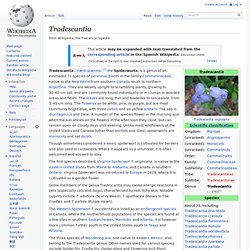
They are weakly upright to scrambling plants, growing to 30–60 cm tall, and are commonly found individually or in clumps in wooded areas and fields. The leaves are long, thin and bladelike to lanceolate, from 3–45 cm long. The flowers can be white, pink, or purple, but are most commonly bright blue, with three petals and six yellow anthers.
The sap is mucilaginous and clear. A number of the species flower in the morning and when the sun shines on the flowers in the afternoon they close, but can remain open on cloudy days until evening. Burdock. Arctium is a genus of biennial plants commonly known as burdock, family Asteraceae.
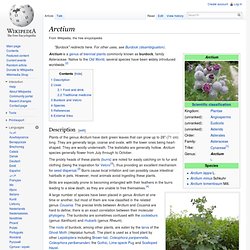
Native to the Old World, several species have been widely introduced worldwide.[2] Smilax Vine. For another plant sometimes called Smilax see Asparagus asparagoides.
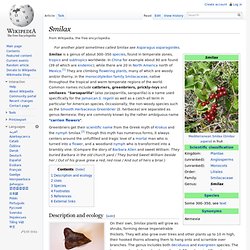
Description and ecology[edit] A typical Smilax sp. leaf On their own, Smilax plants will grow as shrubs, forming dense impenetrable thickets. They will also grow over trees and other plants up to 10 m high, their hooked thorns allowing them to hang onto and scramble over branches. The genus includes both deciduous and evergreen species. Greenbrier is dioecious. Sand Spurs. It is native to North America.

Sea Oats. Uniola paniculata, or sea oats, is a species of grass that grows along the East Coast and the Gulf Coast of the United States, Mexico, and on islands in the Caribbean.
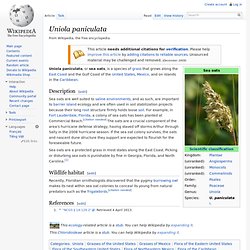
Description[edit] Sea oats are well suited to saline environments, and as such, are important to barrier island ecology and are often used in soil stabilization projects because their long root structure firmly holds loose soil. For example, in Fort Lauderdale, Florida, a colony of sea oats has been planted at Commercial Beach. [citation needed] The oats are a crucial component of the area's hurricane defense strategy, having staved off storms Arthur through Sally in the 2008 hurricane season. If the sea oat colony survives, the oats and nascent dune structure they support are expected to flourish for the foreseeable future.
Sea oats are a protected grass in most states along the East Coast. Yucca. Monkey Grass. Ophiopogon japonicus (Mondo grass, Fountain plant, monkey grass; Japanese: リュウノヒゲ ryu-no-hige ("dragon's beard") or ジャノヒゲ ja-no-hige ("snake's beard") is a species of Ophiopogon native to China, Vietnam, India, and Japan.

Growth[edit] It is an evergreen, sod-forming perennial plant. The leaves are linear, 20–40 cm long. The flowers are white to pale lilac, borne in a short raceme on a 5–10 cm stem. The fruit is a blue berry 5 mm diameter.[1] The roots are large stolens with tuberous roots.[2] Spider Plant. Chlorophytum comosum, often called the spider plant, airplane plant or hen-and-chickens,[2] is a flowering perennial herb. It is native to tropical and southern Africa, but has become naturalized in other parts of the world, including western Australia.[3][4] Variegated forms in particular are used as houseplants.
Description[edit] Chlorophytum comosum grows to about 60 centimetres (24 in) high. Asparagus Fern -aethiopicus. Asparagus aethiopicus, Sprenger's Asparagus, is a plant native to South Africa.
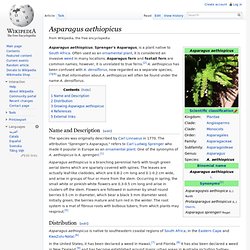
Often used as an ornamental plant, it is considered an invasive weed in many locations. Asparagus fern and foxtail fern are common names; however, it is unrelated to true ferns.[2] A. aethiopicus has been confused with A. densiflorus, now regarded as a separate species,[3][4] so that information about A. aethiopicus will often be found under the name A. densiflorus. Name and Description[edit] The species was originally described by Carl Linnaeus in 1770. The attribution "Sprenger's Asparagus," refers to Carl Ludwig Sprenger who made it popular in Europe as an ornamental plant. Asparagus Fern -setaceus. It is native to Southern Africa, and is grown elsewhere as an ornamental plant.
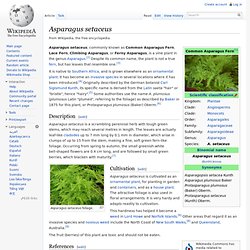
It has become an invasive species in several locations where it has been introduced.[4] Originally described by the German botanist Carl Sigismund Kunth, its specific name is derived from the Latin saeta "hair" or "bristle", hence "hairy".[5] Some authorities use the name A. plumosus (plumosus Latin "plumed", referring to the foliage) as described by Baker in 1875 for this plant, or Protasparagus plumosus (Baker) Oberm.[6] Description[edit] Asparagus setaceus is a scrambling perennial herb with tough green stems, which may reach several metres in length. The leaves are actually leaf-like cladodes up to 7 mm long by 0.1 mm in diameter, which arise in clumps of up to 15 from the stem, making a fine, soft green fern-like foliage. Occurring from spring to autumn, the small greenish-white bell-shaped flowers are 0.4 cm long, and are followed by small green berries, which blacken with maturity.[7]
Saw Palmetto. The generic name honors American botanist Sereno Watson.
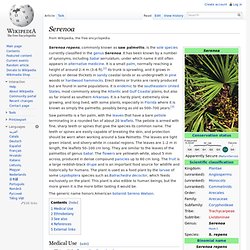
Medical Use[edit] The fruits of the saw palmetto are highly enriched with fatty acids and phytosterols, and extracts of the fruits have been the subject of intensive research for the symptomatic treatment of benign prostatic hyperplasia (BPH). Numerous meta-analyses of clinical trials S. repens extract in the treatment of BPH have found it safe and effective for mild-to-moderate BPH compared to placebo, finasteride, and tamsulosin[4][5] Two larger trials found the extract no different from placebo.[6][7] An updated meta-analysis including these trials found that saw palmetto extract "was not more effective than placebo for treatment of hyperplasia but following two million U.S. who use saw palmetto, urinary problems are greatly reduced.[8] However, saw palmetto extract was comparable to tamsulosin and finasteride in this meta-analysis.
S. repens extract has been promoted as useful for people with prostate cancer. Scrub Palmetto. Description[edit] Detail of the leaf of Sabal etonia Sabal etonia is a fan palm with a solitary stem that is usually subterranean but is sometimes above ground and up to 2 metres (6.6 ft) tall. Plants usually have 4–7 costapalmate leaves, each with 25–50 leaflets. Sabal Palm - 'Birmingham' Live oak. This article is about evergreen oak trees. For the common live oak in the southern United States, see southern live oak. For places named Live Oak, see Live Oak. Live oak or evergreen oak is a general term for a number of unrelated oaks in several different sections of the genus Quercus that happen to share the characteristic of evergreen foliage.[1] Magnolia. Lacebark Elm. Ulmus parvifolia, commonly known as the Chinese Elm[1] or Lacebark Elm, is a species native to China, Japan, North Korea and Vietnam.[2] It has been described as "one of the most splendid elms, having the poise of a graceful Nothofagus".[3] Description[edit]
Crepe Myrtle. Bottlebrush. Firecracker Plant. Russelia equisetiformis and Russelia sarmentosa are commonly used to hide unattractive retaining walls or fences because they grow quickly and have dense foliage. Growing to a maximum height of 1.8 m (5.9 ft), they are shrubs which will tolerate full sun to partial shade. Morning glory. Lipstick Plant. The genus contains a large variety of plants with differing features. Mother-in-Law Plant. Etymology[edit] The genus was originally named Sanseverinia by Petagna to honor his patron Pietro Antonio Sanseverino, Count of Chiaromonte (1724-1771), but the name was altered for unknown reasons by Thunberg, possibly influenced by the name of Raimondo di Sangro (1710–1771), prince of San Severo in Italy.
Spellings "Sanseveria" and "Sanseviera" are commonly seen as well, the confusion deriving from alternate spellings of the Italian place name. Pansy. Daylily. Easter Lily. Paperwhites. Mexican Petunia. Hibiscus. Nightblooming cereus. Agapanthus. Elephant Ear. Mother of a Thousand.